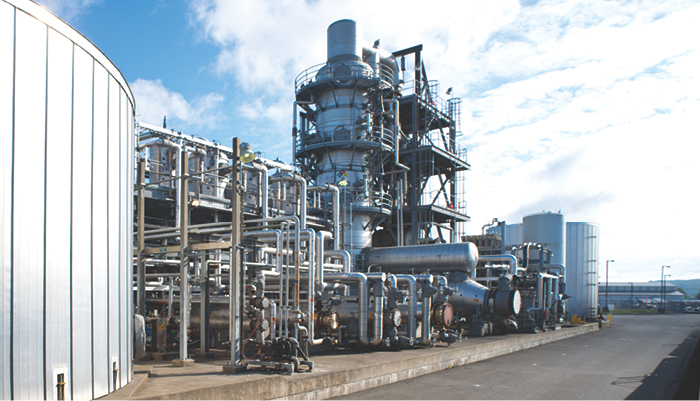All
Feedstock Flexibility
by Dave Slade, Executive Director, Biofuel Technology and Services, Renewable Energy Group, Inc.

Creating High-Quality Biodiesel Regardless of Feedstock
The former science teacher in me still likes quizzes, so here’s a quick one for you. First, list some of the most common biodiesel feedstocks.
I’ll help you with this part. There’s soybean oil, inedible corn oil, canola oil, poultry fat, beef tallow and used cooking oil, to name a few.
Now, what do they have in common?
The correct answer is that all of them can be used to create high-quality biodiesel.
That may come as a surprise. After all, I’ve found that many people in the transportation and heating oil industries believe that soybean oil is the best biodiesel feedstock. Soybean oil is just fine. But there is no “best” feedstock, at least not for skilled producers. The best biodiesel producers can create high-quality, great-performing biodiesel from a wide variety of feedstocks.
The practice is known as feedstock flexibility. And it has many benefits for people up and down the supply chain. Here are the top advantages:
- Predictable pricing and availability. Using multiple feedstocks frees a producer from some of the instability of commodity markets, and this provides economic and supply chain advantages to customers. When prices rise or supply is short on a certain feedstock, a multi-feedstock refinery can switch to an alternative and not negatively affect the finished biodiesel.
- Capture the best properties from different feedstocks. High-tech producers can combine fatty acids from various feedstocks — kind of like ingredients in a recipe — to create a fuel with the properties a customer wants.
- Lower carbon intensity. Feedstock flexibility allows producers to use feedstocks with lower carbon intensity scores, such as used cooking oil and inedible corn oil. Reducing fossil carbon emissions has become a major goal among corporations, governments, fleets and the public as the environmental sustainability trend grows in importance. It’s also required in places with carbon-cutting policies, like California and Oregon.
How Feedstock Flexibility Works
The benefits described above explain why feedstock flexibility is a good thing for heating oil and diesel fuel users. I also want to explain the “how.”
For a skilled biodiesel producer, feedstock doesn’t much matter when it comes to the quality of the end product. The reason is basic science. In biodiesel production, a feedstock is converted into fatty acid methyl esters (FAME) through a chemical process called transesterification. Regardless of the impurities in the feedstock, what is left after this chemical reaction and subsequent refining steps is a mixture of methyl esters, making the original feedstock not particularly relevant.
Experts agree on this. Biodiesel is a legally registered fuel and fuel additive with the U.S. Environmental Protection Agency. That registration requires all biodiesel to meet the ASTM D6751 specification. The specification makes no mention of feedstock, supporting the statement that feedstock does not necessarily impact biodiesel quality or usefulness.
Feedstock Purification
Although feedstock does not have to determine biodiesel quality, it does have some effect on certain attributes of the finished fuel specs. For example, nonedible feedstocks have lower carbon intensity scores. Biodiesel made from animal fats tends to have higher Cetane numbers, higher cloud points, and better oxidation stability than biodiesel made from vegetable oils.
Cloud point is where some people often point to the alleged superiority of soybean oil. But this is where a multi-feedstock approach becomes a difference-maker. How so? I can best explain it by using the refining process I’m most familiar with. You can think of it as occurring in four steps:
- Blending feedstock. By using a mixture of feedstocks to obtain a desirable mixture of fatty acids, a producer can create a finished fuel with the attributes customers want.
- Pretreatment. A rigorous, proprietary pretreatment process in which feedstocks are refined to a very clean and pure material before actual biodiesel production begins.
- Transesterification. The product is further cleaned by conversion to fatty acid methyl esters through the transesterification process.
- Finishing. Continued refining of the biodiesel by further purifying the methyl esters.
Notice how often the product is purified. That’s a big reason why a high-quality fuel can be created no matter the feedstock. Even if it’s a low-cost feedstock with more impurities on delivery, it’s purified to such an extent that its initial state doesn’t affect the end product.
Why Distilled Biodiesel is Even Better
Distillation can enhance a biodiesel producer’s ability to use multiple feedstocks. Distillation is a purification process in which fatty acid methyl esters, which are the molecules that make up biodiesel, are collected by evaporation and minor components that can contribute to filter plugging are left behind in the distillation bottoms. The type and quantity of minor components depend in part on feedstock, so by doing such a good job at removing them, distillation gives a producer more freedom with feedstocks.
Distillation has several advantages over traditionally purified biodiesel, including superior cold weather performance, being a purer product and, thanks to feedstock flexibility, the potential for lower carbon intensity scores and combinations of attributes that aren’t possible from a single feedstock type.
REG takes a feedstock flexible approach at many of its biorefineries and also produces distilled biodiesel. For more information, visit www.regi.com/products-services/.
Related Posts
 Why Quality Matters in Your Biofuel Blends
Why Quality Matters in Your Biofuel Blends
Posted on June 25, 2025
 HEAT Show Gears Up
HEAT Show Gears Up
Posted on June 25, 2025
 What’s Next in Boiler Technology
What’s Next in Boiler Technology
Posted on June 25, 2025
 How Intelligent Are Your Integrated Customer Platforms?
How Intelligent Are Your Integrated Customer Platforms?
Posted on June 25, 2025
Enter your email to receive important news and article updates.
